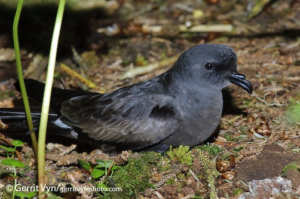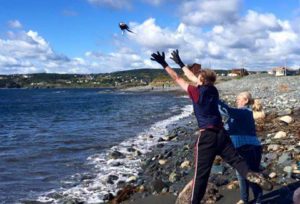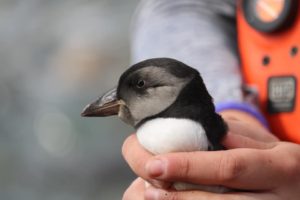Puffin and Petrel Patrol
Since the start of Puffin & Petrel Patrol, the program has rescued thousands of Atlantic Puffin and Leach’s Storm-Petrel chicks and released them back to sea. Now, more than ever, these birds need our help. Both species are globally listed as Vulnerable by the IUCN Red List due to drastic global population declines.
The History
The Petrel and Petrel Patrol Program started in 2004 when Juergen and Elfie Schau of Germany were visiting their summer getaway in Witless Bay. They began noticing young Puffins (named Pufflings) stranded along the roadside and quickly learned that this was a regular occurrence during fledging season. They wanted to help so they recruited local community members to aid in the rescue of the stranded Puffins Since then, what began as a small project involving neighbours and their children has grown into a beloved community tradition of rescuing Puffins and Petrels each year during fledging season.

In the summer of 2011, CPAWS-NL partnered with the Schaus in order to expand and facilitate this program to include the rescue of Leach’s Storm-Petrels and to extend the patrol to include an additional 5 communities surrounding the Witless Bay Ecological Reserve. The Seabird Conservation and Habitat Improvement Program facilitates volunteers to educate and encourage locals to dim or turn off unnecessary lighting, decreasing light pollution.
The Witless Bay Ecological Reserve is home to North America’s largest colony of Atlantic Puffins and the world’s second largest colony of the Leach’s Storm-Petrel, with both having a sum of over 600,000 mating pairs. This ecological reserve runs from the Town of Witless Bay to the Town of Burnt Cove, along the Southern Shore of Newfoundland. Both Puffins and Petrels dig burrows for nests and lay one egg in May or June, which is incubated by both parents. After approximately 7 weeks later the chicks hatch. Atlantic Puffin Chicks begin leaving their nests in late summer, fledging throughout the month of August.

Leach’s Storm-Petrels leave their burrows from September to mid-November. Both species make their way out to sea, where they remain until they are old enough to breed at 4-5 years old. Fledging occurs during the night to avoid predators, using the moon and stars as their navigation system, leading them to the ocean.
This program runs from August – Mid-November each year rescuing Puffin and Petrel chicks. Puffin rescue runs in August and Petrels from September to mid-November. Unlike Puffins, Leach’s Storm-Petrels are nocturnal and these birds are released onto a dark beach the same night they are rescued in the fall months, while Atlantic Puffins are kept overnight and released in the mornings in August.
The Problem
Increased business and residential development in our province, particularly on the Avalon Peninsula, has resulted in an increase in the number of stranded seabirds turning up along our roadways and in backyards.
Under ideal conditions, Atlantic Puffin and Leach’s Storm-Petrel chicks fledge at night and use the stars and the moon as a navigational system, directing them out to sea. Unfortunately, on overcast or foggy nights, many chicks become disoriented and are attracted by artificial lights along the coast. Street lights, vehicle headlights, and home lights can all throw these little birds off course – leading them to navigate toward land instead of out to the open ocean.
For Atlantic Puffins, this is a common occurrence during their fledging season in August as these chicks leave the Witless Bay Ecological Reserve. In mid-September through mid-November, this also happens to Leach’s Storm-Petrels as they fledge from their burrows. Leach’s Storm-Petrels can be found stranded in many places on the Avalon Peninsula as we have the largest Leach’s Storm-Petrel colony in the world (Baccalieu Island) as well as other colonies with large populations like the Witless Bay Ecological Reserve.
Artificial lighting influences the migration, foraging, reproduction and parental behavior of seabirds. It is unlikely that most will find their own way back into the marine environment without the help of patrollers who rescue them. Being seabirds, puffins and petrels find locomotion very difficult on land, and as seabirds they only eat marine life. Even with the Puffin & Petrel Patrol’s dedicated volunteers, hundreds of chicks are still ending up dead in our communities due to this ever-growing issue.
What We Do
 Atlantic Puffin Rescue – Each night during the fledging season in August, volunteers from local communities and those who have travelled far and wide to participate in the program, patrol the community ‘hotspots’ searching for stranded juvenile Atlantic Puffins. Once they are caught, they are housed overnight in crates until they can be released the next morning along the coast. CPAWS-NL facilitates this program and collects information such as locations of stranded birds, environmental conditions, number of active patrollers as well as providing safety equipment to those who partake. Prior to their release, with the assistance of Environment and Climate Change Canada- Canadian Wildlife Service (CWS), puffins are banded, weighed, wing measured, and a sub-sample are swabbed to test for avian influenza. This allows CWS a means to collect information from the seabirds efficiently and without causing disturbance to the breeding colonies. This information contributes to our understanding of the overall health of the puffin population and, if individuals are re-sighted, can give us a clue of where these birds go.
Atlantic Puffin Rescue – Each night during the fledging season in August, volunteers from local communities and those who have travelled far and wide to participate in the program, patrol the community ‘hotspots’ searching for stranded juvenile Atlantic Puffins. Once they are caught, they are housed overnight in crates until they can be released the next morning along the coast. CPAWS-NL facilitates this program and collects information such as locations of stranded birds, environmental conditions, number of active patrollers as well as providing safety equipment to those who partake. Prior to their release, with the assistance of Environment and Climate Change Canada- Canadian Wildlife Service (CWS), puffins are banded, weighed, wing measured, and a sub-sample are swabbed to test for avian influenza. This allows CWS a means to collect information from the seabirds efficiently and without causing disturbance to the breeding colonies. This information contributes to our understanding of the overall health of the puffin population and, if individuals are re-sighted, can give us a clue of where these birds go.
Leach’s Storm-Petrel Rescue – During the fall months, during September to mid-November, Leach’s Storm-Petrel chicks begin their migration seawards. Like pufflings, many young Leach’s Storm-Petrels unfortunately become thrown off-course due to strong winds and light pollution from the coasts. Young inexperienced petrels become stranded on land all across the Avalon Peninsula. CPAWS-NL provides support to members of the public who discover these birds on roads, boats, parking lots, and even downtown St. John’s! Unlike puffins, petrels are nocturnal creatures, which means they are sensitive to the daylight and must be released during the dark hours. It also means that many people have never seen a Leach’s Storm-Petrel before and may not know what kind of bird they have found!
If you find an Atlantic Puffin or Leach’s Storm-Petrel, it is important to contact us at nlpuffinpatrol@cpaws.org or (709) 330-8929
Register to be a Puffin Patrol Volunteer
Thank you for your interest in volunteering with the Puffin and Petrel Patrol! We rely on our volunteers to rescue hundreds of young seabirds every year, and while we are appreciative of the tremendous interest, we prioritize public safety and our program mandate; to mitigate the effects of light pollution on seabirds. Too great a volume of people and traffic in Witless Bay and in surrounding communities can unfortunately create additional light pollution and can cause serious concerns for public, community, and wildlife safety. Therefore, nightly patrols will be restricted to local residents of immediate areas and to pre-registered non-locals (limited registration space is available to those who reside outside of the targeted patrol area).
Non-Locals: To become a Puffin Patrol volunteer, you will have to register.
Make sure you choose a date and training slot that has enough free spaces for yourself and your group. Everyone, including children, will need to register by carload (one registration form per carload of people). Children under the age of 18 will require consent from their legal parent or guardian. Everyone must sign the waiver below before their patrol.
Before Your Patrol Shift
Help us keep Puffin and Petrel Patrol program going: Every year, we need to replace missing and damaged equipment, hire staff, and print materials and permits. We also do a lot of important behind-the-scenes work to reduce the impact of artificial light pollution in on these vulnerable seabirds. Visit our donation page and consider giving a gift of $15 per patroller to help us keep our important work going.
On the Day of Your Patrol Shift
Arrive to headquarters 10 minutes before your scheduled shift. Remember that if you are based in St. John’s, it is about a half hour drive to the community of Bay Bulls. Plan your trip accordingly.
Before arriving, please will out a waiver.
Prior to patrolling, every Patroller is required to take part in a brief training session, with plenty of opportunities to ask questions. After successfully completing your training, you will receive a permit, a map and will be able to sign out equipment to start patrolling. Everyone will also be required to sign a waiver prior to Patrolling for their safety.
Unfortunately due to COVID-19 we are unable to lend out safety gear. Every patroller MUST bring their own safety vest, gloves, and flashlight. We will provide crates and nets, which will be sanitized after each use. You will also need your own vehicle to patrol as the search area is quite large, and spread out.
All captured seabirds will be released the following morning on the local tour boats. Everyone can purchase tickets for boat tour releases (cost at the discretion of the Tour Boat Operators). If interested in attending a boat release, please check with boat tour operators for tickets and availability. Check our social media for current information on releases.
Puffin and Petrel Patrol
If you are a resident or staying in a coastal area along the Avalon Peninsula during the Summer and Fall fledging seasons…
- Dim or turn off unnecessary lighting
- Use motion sensor lighting around your property
- Use window coverings on windows that face the coastline
- Report any sightings of puffins and petrels on your property
- Volunteer to be an active patroller – registration info coming soon!
Puffin Facts
The Atlantic Puffin ( Fratercula Arctica)

- Global population: 12,000,000 – 14,000,000
- Witless Bay Ecological Reserve population: North America’s largest colony of over 300 000 mating pairs (600, 000 adults).
- Global IUCN listing: Vulnerable (visit the IUCN website for details on this assessment)
Atlantic Puffins eat small fish and can dive up to 70m underwater to catch them. Puffins mate for life and will return to the same location to mate. Puffins dig burrows for nests and lay one egg in May or June which is incubated by both parents. Chicks hatch in June or July and begin leaving their nests about 7 weeks after being laid, making their way out to sea where they remain floating on the ocean until they reach adulthood (4-5 years). Though we associate Atlantic Puffins with colourful beaks (or bills), they actually aren’t always that colour! During the winter months, their beaks are a black/grey, during spring/summer their beaks change into the beautiful colours we are used to seeing, to entice mating. Puffins can live for about 22 years.

Weighing in at just a little larger than a budgie bird, with long wings, black feathers, a hooked beak and a bright white patch on the lower back the Leach’s Storm Petrel is unmistakable. Leach’s Storm Petrels have a distinctive tube nose, which allows them to excrete excess salt. Leach’s Storm Petrels are nocturnal, meaning they are active at night. Like puffins, petrel parents lay a single egg and take turns incubating the egg. Chicks hatch in late June to early-August, and leave their nest during the night in mid-September to late October. Parents feed their chicks by regurgitation when they visit at night. After hatching, it takes approximately 9-10 weeks until the chick leaves the nest!
Mid-September through October is the time of year when juvenile Leach’s Storm Petrels fledge their burrows to make their way out to sea. These long life seabirds live over 20 years on average and during the winter, travel all the way to the waters of Peru and South Africa.
Quick Facts:
- Global population: 6,700, 000 – 8,300,000
- Witless Bay Ecological Reserve populations: contains the second largest colony of Leach’s Storm Petrels in Newfoundland and Labrador, with over 300, 000 pairs (600,000 adults).
- Global IUCN listing: Vulnerable (visit the IUCN website for more details on the assessment)
- The largest Leach’s Storm Petrel colony in the WORLD is Baccalieu Island Ecological reserve, located at the entrance to Conception Bay!
Frequently Asked Questions
What is the Puffin & Petrel Patrol? The Puffin & Petrel Patrol is community-driven initiative to save land-stranded puffin and petrel chicks , started by Juergen and Elfie Schau with the assistance of the youth of Witless Bay. Since the early beginnings of the program, thousands of chicks have been rescued and returned to their ocean environment.
Why do chicks get stranded inland? Chicks leave their burrows at night, typically using the moon and stars to navigate out to sea. However, on foggy or overcast nights, the chicks become confused by artificial lights on the coast and fly inland instead, becoming stranded on land.
What do they need help getting back to the water? Why can’t they just fly on their own? Both puffins and petrels are seabirds, which means they are built for life in the water, not on land. Did you know, puffins and petrels are excellent under-water flyers! They use their specially shaped wings to propel themselves under water in search of food and to escape predators. Once puffins and petrels get stuck on land, they need a steep slope or helping hand to help lift them back into the air!
Why are only puffin and petrel chicks being stranded? Why are there not also adults? Good question! The most likely reason why we only find young puffins and petrels becoming stranded on land is because they are not yet experienced flyers and navigators like their parents. The chicks that patrollers find on land are only about 7- 10 weeks old!
Why are there so many puffins and petrels at the same time? We find so many chicks around the same time of year each year, because it is at this time that their parents stop providing food for them and so chicks leave their burrows and venture into the world for the first time.
Why don’t the puffins in puffin patrol look like the puffins I see in pictures and on TV? The puffins we rescue in puffin patrol are still very young. They will grow in size and develop bright, colourful bills and feet like their of their parents when they return in a few years time to mate and have their own young.
Links and Resources
News, Web and Magazine Articles
CBC (News article): Up, up and away! Puffin Patrol returns to Witless Bay
Seed of Good Anthropocenes (Web article): Puffin Patrol
Television and Films
The Nature of Things (TV show): Puffin Patrol
Light Attraction Research Happing Summer 2022
Learn more about the exciting research here!
Contact
For media or other inquires, please contact nlpuffinpatrol@cpaws.org.

